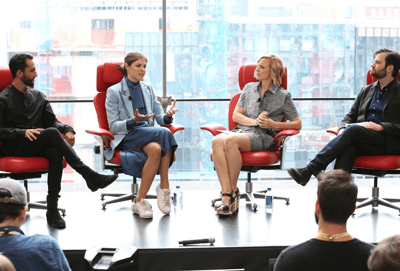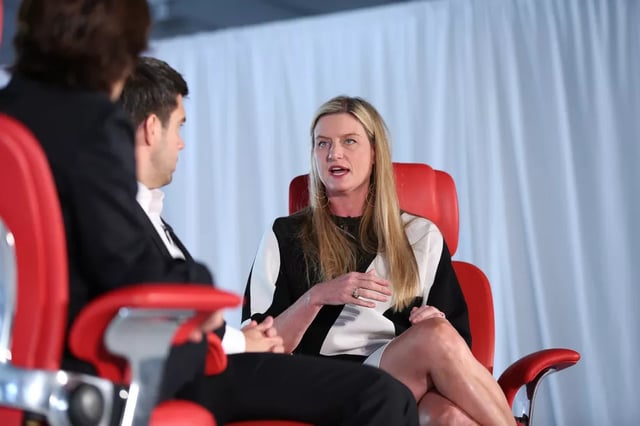On one of the last panels of Code Commerce, Recode’s two-day extravaganza bringing together more than 400 executives from the retail, e-commerce, and digital media worlds, Sweetgreen CEO Jonathan Neman succinctly put into words the main thesis that nearly every speaker hit on during their time on stage: “When it comes to procurement, there are going to be so many more efficient ways [to satisfy customers] … Stores are going to be community centers of story-telling.”
In other words: brick-and-mortar stores are being repurposed from points of sale to experiential, brand marketing epicenters.
“When it comes to procurement, there are going to be so many more efficient ways [to satisfy customers] … Stores are going to be community centers of story-telling.” - Jonathan Neman, co-CEO of Sweetgreen
Though the panels at Code Commerce covered a wide range of topics—for example, celebrity chef Mario Batali waxed poetic on the art of Twitter trolling, NBA Commissioner Adam Silver touched on the future of video gamer fashion, and BuzzFeed exec Ben Kaufman explained the appeal of fidget spinners—this notion of balancing digital with physical was constant.
That shouldn’t come as a surprise, though, especially for anyone who has read the “Retail Prophet” Doug Stephens’ most recent work on the subject, Reengineering Retail. While news stories that claim “retail is dying” often grab the headlines, what’s more fascinating—and what’s importantly explored in Reengineering Retail—is how brands and retailers are adapting in these undeniably fast-changing times. For every entity remotely involved in commerce, adapting means assessing where the company stands from a digital and physical perspective, identifying weaknesses, and innovating to create the most effective ways to reach customers and build brand loyalty.
The Amazon versus Walmart battle is a perfect microcosm of this. On the one hand, you have Walmart, who, despite being the world’s largest company by revenue and operating almost 12,000 physical stores worldwide, has refocused its efforts over the past five years or so to grow its online presence and invest in ecommerce initiatives. On the other hand, there’s Amazon, the world’s largest internet company and the world’s most valuable retailer by market cap, who has recently doubled down on physical growth with its acquisition of Whole Foods and the opening of new Amazon brick-and-mortar stores. Certainly both companies are paving the way for how retailers think about engaging their customers—both Walmart and Amazon know that achieving the perfect mix of digital and physical is crucial to their success.
All-Birds, Bonobos, and Glossier, all of which were represented by their respective founders at Code Commerce, are good examples of this in their own right. Though these brands are digitally native and naturally ecommerce-focused, each has recently made strides to expand physically by opening up brick-and-mortar showrooms, stores, and “guideshops.”
And as Glossier founder and CEO Emily Weiss explains, the goal of those efforts is not necessarily to drive sales—it’s to grow the brand.
“A Glossier customer can buy these products and really understand what works for her online. So the reason she’s actually coming to the store is less to do with trying on product and more to do with experiencing brand,” explained Weiss.
“For us we think less about ‘how do we optimize sales-per-square-foot,’ and more about ‘why would she even leave her house? Why would she even go into a store when she can buy a product and get it delivered?’… We encourage her to spend more time in our experiences, as opposed to getting her in and out and buying something right away.”

“A Glossier customer can buy these products and really understand what works for her online. So the reason she’s actually coming to the store is less to do with trying on product and more to do with experiencing brand,” - Emily Weiss, CEO of Glossier
Glossier is the perfect model of a company that understands the massive opportunity that ecommerce affords from a sales perspective, while also respecting and embracing the larger customer loyalty and brand-building opportunities provided by physical retail.
Williams-Sonoma is another great example of this, though it approaches the subject from the other side of the fence—as a more traditional, brick-and-mortar associated retailer who has embraced online sales channels and digital innovation. The vast majority of the popular home goods retailer’s 60-year existence was during a time when ecommerce didn’t exist at all, yet CEO Laura Alber has adapted her company to the new retail landscape and instilled in her team the notion that excellence in-store must be matched with efficiency and success online.
 Williams-Sonoma CEO Laura Alber at Recode/Shoptalk's joint event, Code Commerce (Courtesy Keith MacDonald)
Williams-Sonoma CEO Laura Alber at Recode/Shoptalk's joint event, Code Commerce (Courtesy Keith MacDonald)
“In the same logic of ‘you need to improve the shopping experience in stores,’ you need to improve the shopping experience digitally,” said Alber. “It’s a big change because, before, retailers like us—specialty retailers—you expected everyone to come to you [physically]. And I actually think that you have to stamp out that thinking and say to yourself, ‘I’m going to go wherever my customers are and I’m going to be agnostic.’ Otherwise you’re not going to make progress.”
If a retailer or brand doesn’t adapt and fails to grasp and capitalize on the benefits of both physical and digital retail, it will not be able to compete. Retail’s most innovative minds, the same ones who spoke at Code Commerce, will continue to push the envelope and ensure that their companies find the most effective ways to reach consumers online and in person. It’s up to the rest of the retail world to keep up.






